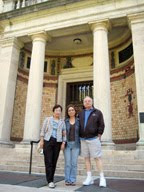
MY MEMORY OPERATES in still frames. I remember the past in a single image, or sometimes as a series of still pictures. No one is ever moving. My memory is stagnant.
I shoot a lot of pictures and they are what I remember from the places I've been, the things I've done. I can remember the context of each and every picture I've ever taken (and I was a professional photographer for a long time).
Looking at those pictures - either the old prints or the digi files - evokes emotions, ideas and, often, a sense of place. Just seeing the images, I recall smells, stories, sounds, expressions. I can remember the exact details - time, names, weather, etc.
I remember feeding Poki and Riri, the two little dogs in the image above, sushi using my chopsticks during the farewell dinner with my family in Japan. I remember drinking sake, my face turning red with every cup. I remember my uncle's eyes welling with tears because his oldest daughter, my cousin, had passed away recently. She would have loved the party.
My problem is that without images, I have a hard time bringing the past to life. I can't imagine the moments, experience the events, or even recall the reason why things occurred. If I didn't take pictures, I can't imagine the event and it fades into nothingness.
I fear that without images, I'll forget everything. Those pictures are my direct link to the past. That's why I always have a camera with me - I'm an unbelievably sentimental person.

I'm interested in why other people care about the past (as well as how they remember it), so I enjoyed the beginning of Rosenzweig and Thelen's
The Presence of the Past. But I quickly became frustrated with the book - the different reasons people appreciate their past are just so disparate, and their tales, I feel, verge on psychology rather than history. Their thoughts are often self-centered - legacies of family violence, finding God, drug abuse, lamenting lost innocence, determining what made them the people they are today, etc.
The
personal past shapes the individual, more than formal history lessons do. I get that. I understand that people want to know their family background - as much for themselves as to pass that history along to future family members. But I'm curious why we remember what we remember. Why do certain things shape our identity more than others? Is that even a question for historians?
Perhaps I was miffed from the get-go, when on page 57, the authors referred to people of mixed racial backgrounds as "half breeds." Nice. Is it 1950 again? Maybe they want to hold on to 1941, as they wrote on page 123, "One of the most important contributions of professional historians has been to foster the idea of nationalism, and the rise of nationalism has in turn fostered the practice of professional history." Seriously? They're boasting about increasing nationalism? Or were they being wry?
Nationalism is way outdated, especially in a country with 300 million people. When
Kanye West is the greatest common denominator among people, the message is clear - we have very little in common with each other. What can be considered "collective history," let alone common knowledge, barely exists.
Rather than harping on the past, I try to live in the present. That's the other reason I take so many pictures. Shooting pictures means appreciating the moment, seeing the beauty in the instant.

That's why I love my dog so much. Mookie (left) runs, sniffs, jumps, barks, spins, dances and fetches with abandon, unencumbered by the events of yesterday. He has habits and he learns stuff, but he's generally uninhibited by the past. His world is right now, a very Zen existence.
I imagine the next step in the concept of public history is figuring out how to make history relevant to a wider audience, and establish commonalities as to what makes for important history.
It's ironic that you have to be visionary in order to make people appreciate history beyond their own past.
 THE BARNES FOUNDATION gallery is among the most amazing collections of art I've ever seen. You can get within sneezing distance of the 181 Renoir's, 69 Cezanne's, 59 Matisse's and handful of Van Gogh's.
THE BARNES FOUNDATION gallery is among the most amazing collections of art I've ever seen. You can get within sneezing distance of the 181 Renoir's, 69 Cezanne's, 59 Matisse's and handful of Van Gogh's.  Until then, the closest thing you'll get to a family snapshot will be outside the current facility.
Until then, the closest thing you'll get to a family snapshot will be outside the current facility.


















